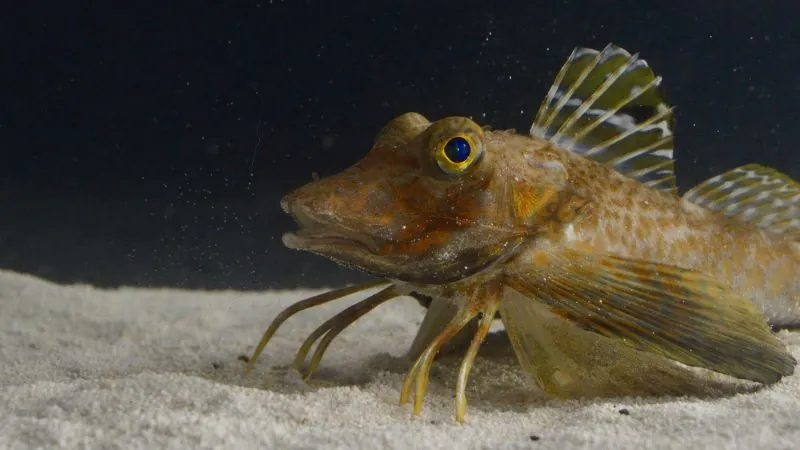
Unveiling the Mysteries of Sea Robins: The Fish with Tasting Legs
2024-09-26
Introduction
In an astonishing revelation from recent scientific findings, researchers have uncovered that certain species of sea robins, unique bottom-dwelling ocean fish, utilize their leglike appendages, which are equipped with taste buds, to 'taste' the seafloor for prey. This fascinating behavior is shedding light on how evolution allows for remarkable adaptations in various animal species.
Behavior and Intelligence
Sea robins are known for their extraordinary ability to scavenge the ocean floor, so much so that they attract the attention of other fish, eager to capitalize on their foraged finds. This is outlined in groundbreaking studies published in the journal *Current Biology*, which delve deep into the biology of these extraordinary creatures.
Research Background
The journey to understanding these peculiar fish began for researcher David Kingsley during a seminar at the Marine Biological Laboratory in Woods Hole, Massachusetts, in 2016. Captivated by their bizarre anatomy – a combination of fish, bird, and crab features – Kingsley initially spotted sea robins in a public aquarium. "I’d never seen a fish that looked like it was made of body parts from many different types of animals," he remarked, sparking an investigation into their adaptive capabilities.
Sensory Appendages
Kingsley, along with his colleagues, set out to study sea robins, uncovering a wealth of surprises, particularly around how their pectoral fins have evolved into sensory appendages that resemble legs. According to Amy Herbert, a coauthor from Kingsley’s lab, these “legs” allow for independent movement that enhances their ability to navigate and forage.
Foraging Behavior
In their controlled studies, researchers examined the digging behavior of sea robins. The results were astounding: these fish could effectively uncover buried prey, demonstrating remarkable foraging skills using their highly sensitive "legs." They even managed to detect food items such as ground-up mussel extract, showcasing their exceptional sensory adaptations.
Species Variance
Interestingly, the research team initially mistakenly mixed two different species of sea robins in their study. They soon discovered that the finely-tuned sensory capabilities belonged to the northern sea robin (Prionotus carolinus), whereas the striped sea robin (Prionotus evolans) lacked such abilities. The northern variety had shovel-shaped legs with taste bud-like protrusions, while the striped variant had rod-shaped legs without the sensory structures.
Evolutionary Implications
This discovery led to intriguing questions regarding evolutionary timelines. The researchers believe that these specialized adaptations arose in specific environments, particularly in the sandy shallows of New England and the eastern Atlantic seaboard. Their findings suggest that the lineage of digging sea robins diverged from non-digging relatives approximately 10 to 20 million years ago.
Key Regulatory Genes
The key to these adaptations lies within a regulatory gene called tbx3a, crucial for the development of both specialized fin adaptations and taste bud-like papillae in sea robins. Remarkably, this gene also plays a role in limb development across many species, including humans.
Hypotheses for Sensory Abilities
But why do only some sea robins possess these sensory abilities? The researchers propose two hypotheses: the first suggests that the ability to use their legs for uncovering prey offers a new feeding strategy; the second hypothesizes that walking may prove to be a more energy-efficient way to navigate certain environments compared to swimming.
Coordinated Movement
The intricate biology of sea robins is further underscored by their unique pectoral fins, which have evolved to allow for coordinated walking movements. Jason Ramsay, a biologist from Rhode Island College, notes that these adaptations may be a combination of both sensory and locomotion functions, making sea robins a remarkable example of evolutionary innovation.
Future Research
As Kingsley and Herbert prepare to launch their own research labs, they remain eager to uncover more about the mechanisms behind the fascinating appendages of sea robins. These studies highlight not only the diversity of life in our oceans but also raise profound questions about evolution, adaptation, and the ecological roles these unusual fish play in their environments.
Conclusion
Stay tuned for more groundbreaking discoveries about the secrets of our oceans!



 Brasil (PT)
Brasil (PT)
 Canada (EN)
Canada (EN)
 Chile (ES)
Chile (ES)
 España (ES)
España (ES)
 France (FR)
France (FR)
 Hong Kong (EN)
Hong Kong (EN)
 Italia (IT)
Italia (IT)
 日本 (JA)
日本 (JA)
 Magyarország (HU)
Magyarország (HU)
 Norge (NO)
Norge (NO)
 Polska (PL)
Polska (PL)
 Schweiz (DE)
Schweiz (DE)
 Singapore (EN)
Singapore (EN)
 Sverige (SV)
Sverige (SV)
 Suomi (FI)
Suomi (FI)
 Türkiye (TR)
Türkiye (TR)